One Store, One Forecast: Architecting Operational Success Through Unified Workforce Management
Retailers today have their work cut out for them when it comes to effectively managing associates. To overcome these challenges, they must develop a strategic approach – one that harmonizes planning, scheduling, and execution seamlessly. But where should they start?
In this conversation with Dan Bursik, Logile's senior vice president of product management, we explore the importance of building a single source of truth in retail workforce management, moving towards the concept of “one store, one forecast” to build a more personalized, data-driven workforce management strategy.
Delving into the challenges and the promising approaches to tackle them, Bursik shares insights on leveraging evolving technologies such as AI and machine learning to finesse forecasting and boost engagement among the retail frontline. Bursik also gives an overview of strategies retailers can employ to build a more unified and transparent workforce management system, charting a course for enhanced productivity, efficiency, and – ultimately – greater customer satisfaction.
CSA: What is one of the most promising approaches retailers can consider right now to manage labor despite ongoing challenges?
Dan Bursik: Attracting and retaining great associates is a challenge every retailer faces, especially in today's tight labor market. It's particularly challenging to find the most qualified people with the optimal skillset, who want to work when retailers need coverage. The time is right to put in systems that empower your workforce and increase efficiency – especially if you're not currently using a labor model with store-specific work standards and characteristics to truly understand the work content of each store. Your platform should support an earned hours approach so you can effectively plan, schedule, execute, and continuously improve. In addition to matching your work requirements with associate availability and skills, the best platforms schedule via an interactive employee portal that lets your associates know what tasks they must complete and guides them to success.
These platforms connect your associates to your systems and communicate work assignments to them on tablets or handheld devices. An AI system monitoring real-time streaming data from many sources can automatically prioritize and dispatch changes in work assignments when they are needed. It automates the smart adjustments to your plan that a seasoned manager would make. That might be to flex help to a department where additional service is needed at a certain time. Or, when the store is short of help for a time, it can defer certain tasks to focus on what is most important. Or when you have extra capacity, it can pull work forward to utilize the time. These data-driven adjustments automated through your devices can help your store teams be successful even with less experience. By creating a connected workforce, you engage associates and enable them to be more productive.
Offering flexibility and the most employee-friendly schedules possible is also critical. That may mean providing options like gig-style scheduling, where associates can pick up shifts that fit their lives without committing to a recurring schedule. These strategies go a long way towards making any retailer an employer of choice in their market and retaining good people. They ultimately enable your store team to deliver your brand in a way that can differentiate you from the many choices customers have these days across the omnichannel.
CSA: We often hear about the importance of creating a single source of truth. But what does that mean and look like in practice, particularly in the context of retail workforce management?
Bursik: A few things come to mind. First, there must be alignment in the ways the business plans, schedules, and executes its strategies. When people are misaligned in what the business sets out to do, how it tries to do it, and what success looks like, it creates stress, reduces teamwork, and undermines success. For instance, if you plan and advertise a promotion, but the store doesn't have the inventory on hand to deliver that plan, both customers and associates will be frustrated. They may lose confidence in your brand and wonder why the right hand doesn’t know what the left hand is doing. Is there one plan, or different plans executed in silos? If one system contains a set of KPI numbers that differs from another system, it causes confusion and inability to discern what is correct. It is also difficult to build accountability and ownership if you don't have a clear perspective – or if your information or priorities change based on who's asking or what system you're consulting. People can’t do their best work for you in such an environment. At Logile, we're providing retailers with the capability to generate a multilayered, multidimensional forecast designed to support all aspects of their organization. “One store, one forecast” will be a key driver for that single version of truth for retailers.
CSA: What strategies can retailers leverage at the store level to help create a more connected workforce experience?
Bursik: Having the right system makes a big difference in connecting, engaging, and empowering your associates with the tools they need to do their work efficiently and effectively. This starts with an accurate forecast as the foundation for effective staffing and work planning. The ability to plan at the task level rather than job-level scheduling enables associates to focus on the right things. Also, daily or intraday reforecasting allows planned work assignments and production plans to be updated as needed to respond to changes in sales volume, new promotions, weather or team staffing – all the daily surprises that every retailer experiences.
Having an updated plan is good, but then you need an effective employee portal to connect your associates to that plan, communicate the changes, and guide and support every associate as they do the work. Associates are set up for success when they know what they need to accomplish and when they have a system that enables them to work faster, get information quicker, and get guidance when needed – all without having to ask their manager or wait to be told. The right system enables associates to accomplish more by working smarter. An associate who can clock out knowing they accomplished what was expected is going to feel better about themselves and their experience at work. That is empowering for associates, enables retailers to weather unavoidable turnover and speed new hires through the learning curve more easily, and enables stores to deliver better service to customers, even with fewer hours. The next generation of AI-enriched systems allows a retailer to integrate forecasting, work planning, scheduling, reforecasting and task management, with an associate portal like you've never been able to do before. Our mobile associate portal, Logile Connect, is a powerful tool for creating a connected workforce.
CSA: What role do evolving technologies like generative AI and machine learning play in improving workforce experience? How can these technologies help retailers to manage labor more effectively?
Bursik: AI offers incredible opportunities to empower a connected workforce, increase productivity, and deliver better quality and customer service. A retail store is defined by the goods customers buy and the service and experience they receive. If workforce management is about putting the right people in the right place at the right time doing the right things, and if inventory management is about having the right goods presented in the right ways in the right quantities and place, then coordinated planning, scheduling, and executing effectively is the key to making all of those things happen. A good forecast is critical for labor and inventory management. You can't get a good schedule out of a bad forecast. And, you can't reduce shrink and prevent out-of-stocks without accurate ordering and smart production planning to support your merchandising. A unified AI-powered forecast and iterative reforecasting are the secret sauce enablers bringing it all together better, faster, and more reliably. Leveraging this unified forecast for labor and inventory planning makes success possible even with less experienced associates and less experienced managers. There's almost no aspect of our forecasting, planning, scheduling, and execution functionality that has not been significantly upgraded through the use of artificial intelligence.
At Logile, our use of AI goes far beyond the generative AI that people associate with chatbots or quick content creation. Aside from forecasting, we use AI to identify issues you must resolve before a schedule is written, or to determine why a particular person should be scheduled instead of someone else. If edits are required, we expect AI to offer schedule writers suggestions. If you find yourself short-handed due to last-minute call-offs, AI can prioritize the work and reassign associates to the most important activities. AI and machine learning algorithms make all those things possible, and that's why AI is so transformative.
CSA: What approaches can retailers take to build a more unified and transparent workforce management system, and what recommendations would you make for any retailers who are kind of new starting on this journey?
Bursik: My advice is to focus on developing an accurate labor model that reflects your business priorities and your service standards. Know your stores’ work content. Be honest about what it takes to deliver your brand in each one of your markets. Then use your labor model to implement an earned hours program and give your stores the tools they need to empower your associates to be successful. Of course, you need to maintain dashboard visibility into your business and KPIs and use that data to make informed decisions.
If you need help to develop your standards or upgrade your systems, then find the right vendor who will partner with and support you just like they're an extension of your team.






